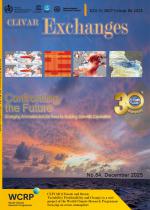CASO Proposal
Southern Ocean processes have global reach. Ocean circulation and water mass formation in the Southern Ocean regulate the ocean storage and transport of heat, freshwater and anthropogenic carbon dioxide; link the upper and lower limbs of the global overturning circulation; and return nutrients to the surface ocean to support a large fraction of global productivity. Changes in Southern Ocean currents and sea ice can drive significant climate feedbacks. The circulation of the Southern Ocean reflects complex interactions between the atmosphere, ocean and ice, including the effect of oceanic and atmospheric teleconnections between low and high latitudes. The ice of Antarctica provides a unique record of climate variations on time-scales from 1-100,000 years. While the past decade has seen a rapidly growing appreciation of the role of the Southern Ocean and Antarctica in the global climate system, a lack of observations continues to hinder attempts to understand how the region drives and responds to climate change and variability.
The International Polar Year (IPY) provides an unprecedented opportunity to fill this gap. The Climate of Antarctica and the Southern Ocean (CASO) program provides a strategy to integrate climate research activities during the IPY. By pooling resources and taking advantage of new technologies, CASO aims to obtain the first synoptic, multi-disciplinary snapshot of the Southern Ocean region (including atmosphere, ocean, cryosphere and aspects of the biosphere).
The Climate of Antarctica and the Southern Ocean (CASO) program is organized into five themes, with the following objectives:
1. Antarctica and the Southern Ocean in the global water cycle: To quantify the high-latitude contributions to the global water cycle, determine the sensitivity of the water cycle to climate change and variability, and identify the impact of changes in the high latitude water cycle on the rest of the globe.
2. Southern hemisphere teleconnections: To understand the climate connections between low and high latitudes, including both atmospheric and oceanic pathways; determine the role of air-ice-ocean interactions in southern hemisphere variability and change; and assess the sensitivity of the modes of variability to future change.
3. Climate processes at the Antarctic continental margin: To improve our understanding and models of ocean-ice-atmosphere interactions and ice shelf stability; obtain a snapshot of the circumpolar distribution of the complex system of coastal, shelf and slope currents; quantify the production rate of Antarctic Bottom Water and implement an observing system; measure the circumpolar volume of sea ice.
4. Climate – ecosystem – biogeochemistry interactions in the Southern Ocean: To understand the impact of climate variability and change on Southern Ocean ecosystems, biodiversity and biogeochemical cycles, including the role of the Southern Ocean in the CO2 cycle.
5. Records of past Antarctic climate variability and change: To use proxy records to determine the natural modes of climate variability on time-scales from years to millennia and improve our understanding of the mechanisms of abrupt climate change in the past, including the role of northern versus southern hemisphere.
Implementation
CASO is taking the lead in the Antarctic Ocean Circulation cluster. The CASO cluster will be integrated closely with other clusters, including programs studying ocean circulation near the Antarctic margin (SASSI), biogeochemistry (GEOTRACES), sea ice, meteorology (ACAC), ecology (ICED-IPY) and paleoclimate (IPICS-IPY). The CASO cluster includes 25 individual projects and involves scientists from 18 nations.
The specific goals of the CASO ocean circulation cluster are:
1. To obtain a synoptic circumpolar snapshot of the physical environment of the Southern Ocean (collaboration with other IPY activities will extend the snapshot to include biogeochemistry, ecology, and biodiversity).
2. To enhance understanding of the role of the Southern Ocean in past, present and future climate, including connections between the zonal and meridional circulation of the Southern Ocean, water mass transformation, atmospheric variability, ocean-cryosphere interactions, physical-biogeochemical-ecological linkages, and teleconnections between polar and lower latitudes.
The field program to meet these goals will include:
1. A circumpolar array of full-depth multi-disciplinary hydrographic sections and XBT/XCTD sections, extending from the Antarctic continent northward across the Antarctic Circumpolar Current, including key water mass formation regions.
2. An enhanced circumpolar array of sea ice drifters, measuring a range of ice, ocean and atmosphere parameters.
3. Profiling floats deployed throughout the Southern Ocean, including acoustically-tracked floats in ice-covered areas.
4. Current meter moorings and pressure gauges to provide time series of ocean currents and water mass properties at key passages, in centres of action of dominant modes of variability, and in areas of bottom water formation and export.
5. Direct measurements of diapycnal and isopycnal mixing rates in the Southern Ocean.
6. Automatic weather stations, flux measurements in the boundary layer and drifters to measure atmospheric variability (pressure, winds, heat and freshwater flux).
7. Environmental sensors deployed on marine mammals.
The observations will be integrated closely with modelling studies using a variety of approaches (coupled climate models; high resolution ocean-ice models; atmospheric models; tidal models; Lagrangian diagnostic studies).
Legacy
The legacy of CASO will include improved climate predictions, from models that incorporate a better understanding of southern polar processes; proof of concept of a viable, cost-effective, sustained observing system for the southern polar regions (including the ocean, atmosphere and cryosphere); and a baseline for the assessment of future change.
Download the Full Proposal (pdf)










